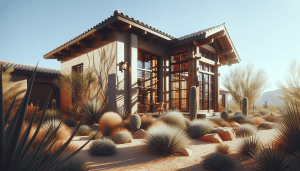At Arizona Window Company, we understand how frustrating leaky windows can be for homeowners. Addressing these issues promptly can save you money and prevent further damage to your home. In this article, we’ll cover advanced techniques for repairing leaky windows, specifically designed for our audience in Arizona. Whether you’re a DIY enthusiast or considering professional help, this guide is packed with practical solutions to keep your windows sealed.
Contents
- 1 Identifying the Source of the Leak
- 2 Sealing Gaps and Cracks
- 3 Ensuring Proper Window Alignment
- 4 Replacing Worn Weatherstripping
- 5 Reapplying Caulk
- 6 Inspecting and Fixing Window Frames
- 7 Installing Storm Windows
- 8 Advanced Inspection Tools
- 9 Hiring Professional Services
- 10 Benefits of Regular Maintenance
Identifying the Source of the Leak
Before diving into repairs, it’s crucial to pinpoint where the leak is coming from. Look for signs like water stains, peeling paint, or condensation between window panes. Knowing the exact location will guide your repair efforts and prevent you from making unnecessary fixes. This step can be the difference between quick success and prolonged frustration.
Once you have identified the problem areas, it’s time to assess what might be causing them. This could be due to old and worn hardware, damaged seals, or even issues with the window frame itself. Every cause has a corresponding solution, so understanding this will set you on the right path.
Sealing Gaps and Cracks
Gaps and cracks are common culprits when it comes to leaky windows. To combat this, weatherstripping and caulking are your best friends. Weatherstripping is perfect for movable parts, while caulk is great for stationary gaps. Together, these methods form a formidable barrier against leaks.
When applying these materials, ensure that surfaces are clean and dry. A proper seal is only as good as its application, so take your time to do it right. This effort will pay off in the long-term with a sturdy, leak-proof seal.
Ensuring Proper Window Alignment
Improper alignment can be a hidden cause of window leaks. If the window doesn’t sit correctly in its frame, it can create small gaps that let in outside elements. Adjusting the window alignment involves manipulating the hinges or tracks to ensure smooth operation and a tight seal.
To check for alignment issues, open and close the window several times. It should move effortlessly without sticking or leaving gaps. If there are issues, minor adjustments or tightening screws might solve the problem.
Replacing Worn Weatherstripping
Over time, weatherstripping can wear out, losing its effectiveness. If you notice drafts or increased energy bills, it might be time to replace it. Remove the old weatherstripping carefully to avoid damaging the window frame. Clean the surface before applying new material for the best results.
Different types of weatherstripping are available, each suited to particular needs and window types. Consider talking to a professional if you’re unsure which kind is best for your windows. This small upgrade can significantly enhance your home’s energy efficiency.
Reapplying Caulk
Caulking isn’t just a one-time fix. Over the years, the caulk around your windows might crack or peel away, necessitating a refresh. Start by removing old, damaged caulk using a putty knife. Ensure the surface is completely clean and dry before applying a fresh bead of caulk.
Follow the window frame’s contours smoothly for a clean finish. This not only enhances the appearance but also maximizes the caulk’s effectiveness. You’ll be surprised at how this simple task can dramatically improve your window’s performance.
Inspecting and Fixing Window Frames
Window frames can be a serious source of leaks if they’re not in top condition. Check for signs of rot, warping, or any other types of damage. Wood frames are particularly susceptible to weather-related problems, so regular inspections are crucial.
If you find any damage, repairs might involve sanding or replacing parts of the frame. This can be a bit more labor-intensive but addressing these issues early can prevent more extensive damage down the line.
Installing Storm Windows
Homeowners in areas prone to severe weather can benefit from installing storm windows. These act as a secondary layer of protection, reducing the impact of elements on your primary windows. They are especially useful in preventing leaks during heavy rain and wind.
By adding this extra layer, not only are you protecting your home, but you’re also creating an additional insulation barrier. This can lower energy costs and enhance the comfort of your living space.
Advanced Inspection Tools
For those tech-savvy homeowners, advanced inspection tools like infrared cameras can help locate leaks that are not visible to the naked eye. These cameras detect temperature differences and can highlight areas where air may be escaping or moisture is entering.
Investing in or renting such tools can give you a comprehensive understanding of your window’s condition. This insight allows for precise repairs, tackling every problem at its root cause.
Hiring Professional Services
Sometimes, the best approach is to call in the experts. We recommend professional services for complicated situations, such as when moisture has penetrated deep into the walls or involves structural components. A professional team can evaluate the issue and offer solutions that might not originally be apparent.
Professionals have access to much more sophisticated tools and materials, ensuring a thorough and lasting repair. Knowing when to seek expert help can save you time and stress in the long run.
Benefits of Regular Maintenance
Undertaking regular window maintenance can prevent leaks from occurring in the first place. Regular cleaning, inspection, and minor repairs will keep your windows in optimal condition. It’s an investment in your home’s longevity and efficiency.
Preventive measures are always easier and cheaper than repairs. Set a schedule for maintenance activities, and your windows will reward you with years of reliable service.
In conclusion, tackling leaky windows doesn’t have to be overwhelming. With these advanced techniques from Arizona Window Company, you can ensure a comfortable and leak-free home. For personalized help, don’t hesitate to Contact Us at 480-526-4456 or Request a Free Quote.




